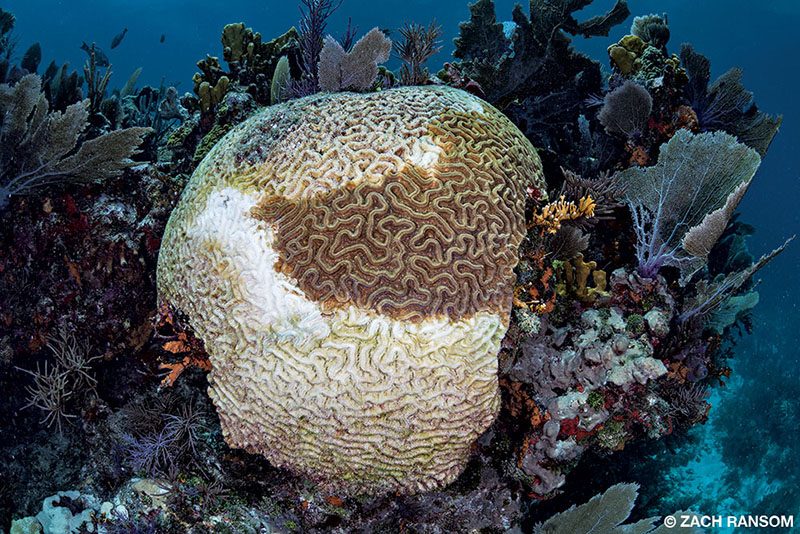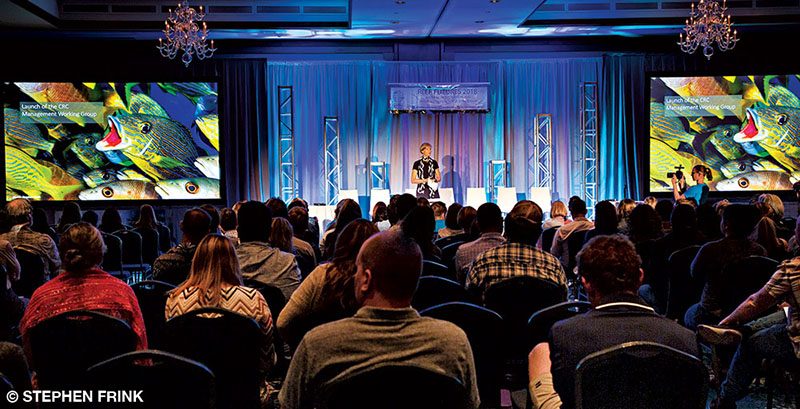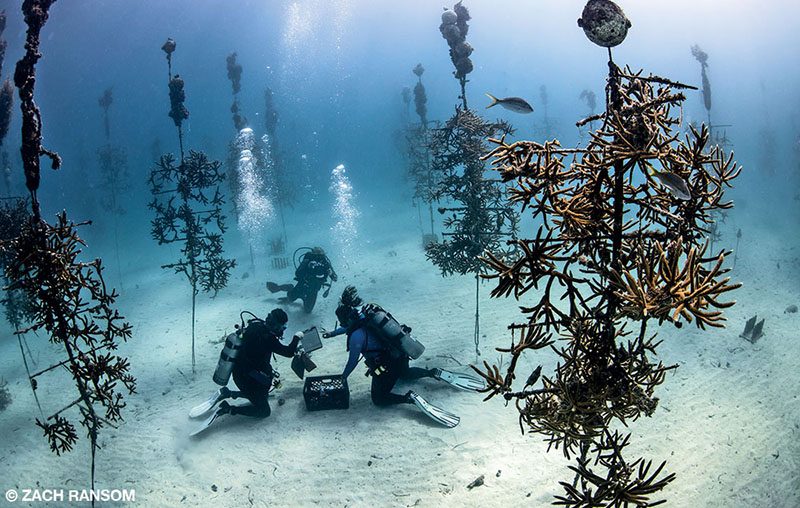Experts contemplate the future of coral reefs
Corals are elegantly simple yet exceedingly complex organisms. This dichotomy can be ascribed to millennia of evolutionary pressure galvanized by a single constant: change. Corals have a remarkable ability to survive and adapt to changes in environmental conditions over a geological timescale. Analogous to what we see today, they have historically experienced extreme fluctuations in ocean temperature and sea level, among other variables, precipitated by tectonic forces and the development of ice ages.
Evidence of this tumult is in some unlikely places, including coral fossils on Mt. Everest, but the main difference between then and now is the timescale. Aside from the occasional cataclysmic mass-extinction event, global atmospheric changes typically take thousands of years to occur — but humans have managed to do it in about 50 years. The science and associated consequences of anthropogenic climate change are undeniable when examined without preconceived notions. These consequences are dire for nearly every ecosystem on the planet, and coral reefs are among the most vulnerable. They protect coastlines, support fisheries and serve as economic engines for coastal communities; humans cannot afford to lose them.
Founded to prevent such loss, the Coral Restoration Consortium (CRC) is a community of scientists, managers, coral restoration practitioners and educators dedicated to helping coral reef ecosystems survive. By fostering scientific collaboration and technology transfer among leading coral experts, they plan to demonstrate that restoration can achieve meaningful results on a large scale.

The Symposium
More than 400 of the world’s leading scientists and experts from about 30 countries gathered Dec. 10–14, 2018, in Key Largo, Florida, for Reef Futures 2018: A Coral Restoration and Intervention-Science Symposium. The conference’s location is significant because it lies amid one of the planet’s most degraded reef systems.
Key Largo is the epicenter of the Florida Reef Tract (FRT), a 360-mile-long bank reef stretching from St. Lucie Inlet in the north to Dry Tortugas National Park in the south. The FRT is currently a shadow of its former self due to a plethora of insults; a mysterious disease outbreak has recently killed an estimated 100,000 corals and continues to spread rapidly. The need for progressive ideas regarding intervention in degrading reef ecosystems is apropos to this place at this time. Despite political and environmental realities, the mood in the room was positive, energized by a collective sense of urgency. Over the several days of presentations covering a range of topics, several recurring themes emerged.

Ancillary Species
Restoring and preserving a coral reef is much more complex than just protecting the corals themselves; the symbioses among reef inhabitants are a vital component to long-term success. An example of such a keystone relationship in the Caribbean involves the long-spined sea urchin, Diadema antillarum. Coral larvae require a relatively clean, algae-free substrate on which to settle and develop into a mature coral colony. Historically the most important shallow-water herbivore in the Caribbean, Diadema help prevent algae from infringing on mature corals and remove noncalcareous algae from the reef structure, which improves the chances of successful sexual reproduction for corals. The decline of Diadema in the Caribbean beginning in the 1980s mirrors that of stony corals, so it is reasonable to hypothesize that Diadema played a crucial role in overall reef health. Through the pioneering work of Martin Moe, which the Florida Aquarium has expanded upon, the ex situ large-scale culturing and dissemination of Diadema antillarum is almost a reality.
Scalable Solutions
As long-term climate forecasts become increasingly calamitous, solutions must be bold enough to produce a desirable outcome. Interventions that would have seemed unlikely 10 years ago are now at the forefront of the conversation. After repeated mass bleaching events on Australia’s Great Barrier Reef in 2016 and 2017, for example, the Australian government committed itself to protecting and restoring the reef on a grand scale by creating the Reef Restoration and Adaptation Program (RRAP).
RRAP experts are thinking outside traditional paradigms to determine the costs and benefits of several potential interventions including a process called marine cloud brightening, by which vessels could spray seawater at high pressure into the atmosphere. The salt crystals provide a nucleation point around which water vapor can accumulate, eventually increasing the surface area of clouds in a localized area, which could reduce sea surface temperatures by reflecting more light energy back into space.
Another sunlight-blocking method under consideration is the application of an ultrathin biodegradable film of calcium carbonate to the ocean’s surface over the most at-risk areas of reefs during certain times of year. The film is largely benign and can reduce light penetration by up to 30 percent.
While RRAP researchers have already deemed infeasible many of the roughly 18 interventions they were investigating, it is necessary to at least have the conversation about potential solutions audacious enough to match our problems. The complexity and consequences of modifying any natural system can’t be overstated; after all, that’s how we came to be in this predicament. The consequences of doing nothing, however, far outweigh the alternative. Even conservative models predict that in many places around the world coral reefs as we know them will cease to exist by the end of this century.

Assisted Evolution
Researchers are also studying how to use genetic enhancement to increase a coral’s fitness to changing environmental conditions. Mary Hagedorn, Ph.D., Smithsonian marine biologist and principal investigator for the Reef Recovery Initiative, is using cryopreserved coral sperm to assist gene flow between genetically distinct Caribbean coral populations. With fewer and fewer genetically distinct corals on a given reef, the chances of successful sexual reproduction are diminished. Introducing gametes of the same species but from different geographic areas into a spawning event greatly improves the chances of increasing genetic diversity of the reef.
Another proposed way to improve coral fitness is known as stress hardening. Marine biologists Rivah Winter, Ph.D., of the Frost Museum of Science, and Andrew Baker, Ph.D., of the University of Miami’s Rosenstiel School of Marine and Atmospheric Science, are investigating the use of controlled stress to induce positive physiological change as a scalable tool to improve the heat tolerance of nursery-grown corals through bleaching and recovery. When temperatures rise, zooxanthellae — symbiotic algae that live within the tissues of most reef-building corals — may leave their hosts, which causes coral bleaching. An increase in heat stress resistance could occur as a result of changes in gene expression within the coral host itself (epigenetic changes). Heat tolerance could also increase if the coral forms its symbiotic relationship with a more heat-resistant algae species during recovery from controlled stress. Such thermally tolerant symbionts may provide a much-needed lifeline for restored corals, allowing them to resist subsequent bleaching stress or to recover more quickly. This methodology could increase the survival rates of outplanted corals, making existing restoration efforts much more effective.
Changing of the Guard
The generation of scientists that first lit the torch of reef conservation and restoration are now passing it on to the next generation. Inspired by pioneers such as Ken Nedimyer, Ruth Gates and David Vaughan, among many others, an increasing number of young people have dedicated their careers to saving coral, spurring an influx of new research and fresh ideas, coupled with innovative technologies. The number of graduate students presenting original research at the symposium spurs hope for the future and brings to mind the felicitous quotation from the environmentalist Baba Dioum: “In the end we will conserve only what we love, we will love only what we understand, and we will understand only what we are taught.”
The Future
The ultimate future of coral reefs remains uncertain; the extent of reef degradation will be determined by the choices we have made and will soon make. The greatest risk would be to do nothing about carbon dioxide (CO2) emissions. Immediate and aggressive action on climate change is paramount for the long-term survival of reefs. The efficacy of the interventions discussed during Reef Futures 2018 are based on atmospheric CO2 levels eventually reaching a peak — the sooner the better.
The good news is that corals have entered the mainstream: Corals are now cool and something beautiful to be protected. More people than ever are exposed to coral reefs not only in the ocean but also in public and home aquaria. Thanks to the research of dedicated scientists around the globe, we now know more about coral than ever before. With the collective knowledge their work has given us, we can streamline restoration efforts and brighten the future for coral reefs.
Explore More
Watch videos of two sessions from Reef Futures 2018: A Coral Restoration and Intervention-Science Symposium. A full playlist for all three days is available online.
© Alert Diver — Q2 2019